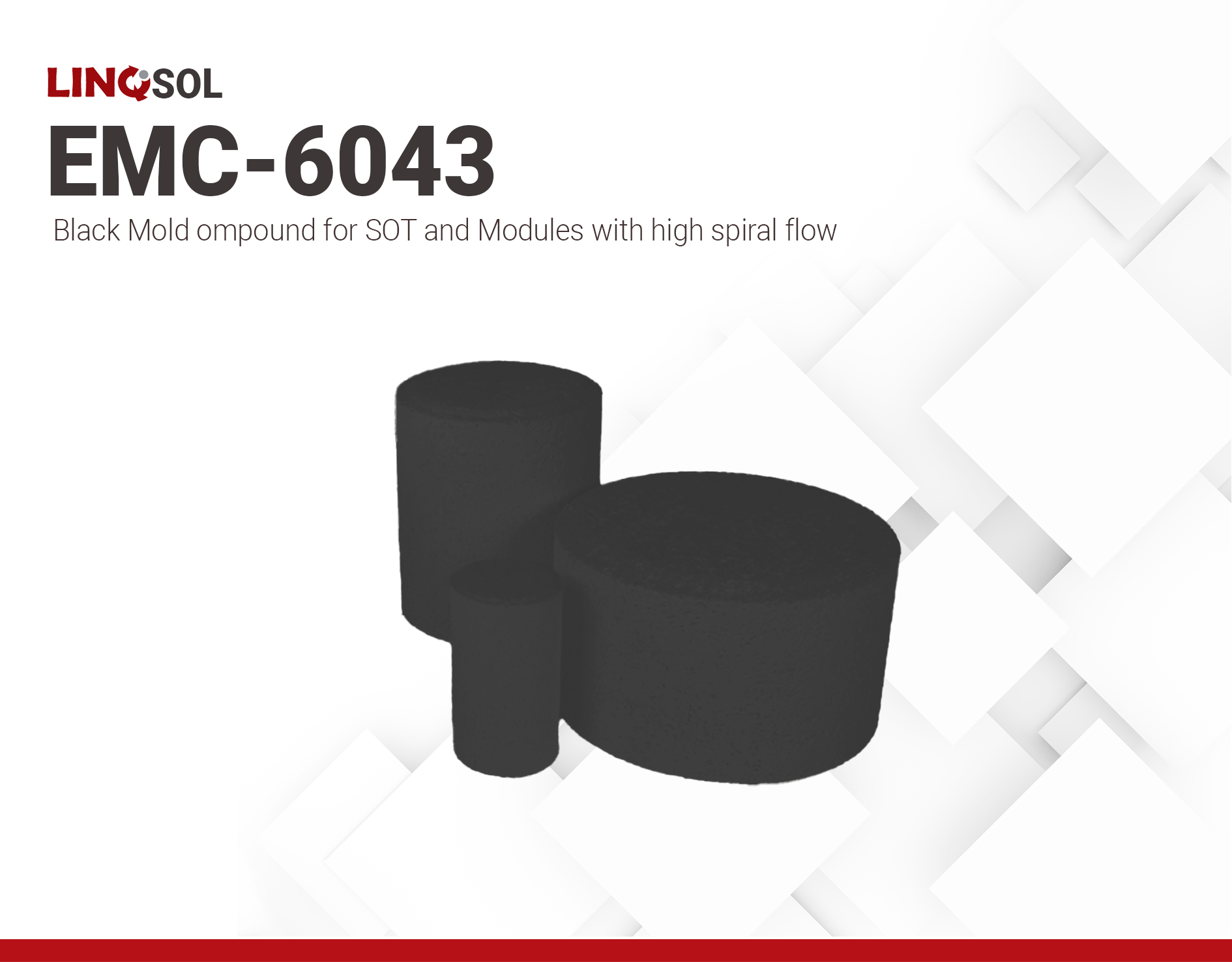LINQSOL EMC-6043 | Black Epoxy Mold Compound
- High Spiral flow
- Designed for SOT and Modules
- Low stress and Low Moisture Absorption
Product Description
LINQSOL EMC-6043 is a green epoxy molding compound developed for the encapsulation of power discrete semiconductor packages, including small outline transistors and modules. It offers high spiral flow to meet stringent moldability requirements. EMC-6043 seamlessly integrates advanced material properties, safety compliance, and superior performance, precisely meeting the requirements of discrete power semiconductor applications.
LINQSOL EMC-6043 is available in custom pellet dimensions. Contact us for more information.
Product Key Features:
- High spiral flow (140 cm) — improves moldability of molding compound, allowing EMC-6043 to fill intricate shapes better.
- Low Moisture Absorption (0.25%) — improves long-term reliability in humid environments.
- High glass transition temperature (Tg =140℃) — ensures that the molding compound remains in a rigid state at elevated temperatures, preventing substantial deformation and stress on the chip.
Applications:
- The coefficient of thermal expansion of LINQSOL EMC-6043 matches that of copper. It is compatible for encapsulation of copper wire coils.
- Also suitable for SOT, modules, and other power discrete semiconductor packages
CAPLINQ also offers other semiconductor mold-related products such as rubber cleaning sheets, melamine cleaning compounds, and wax conditioning sheets. For more information about EMCs, visit CAPLINQ Blog.
Technical Specifications
| General Properties | |||||||||
| Color Color The color | Black | ||||||||
| Filler Content | 85 % | ||||||||
| Filler Size Cut | 75 µm | ||||||||
| Specific Gravity Specific Gravity Specific gravity (SG) is the ratio of the density of a substance to the density of a reference substance; equivalently, it is the ratio of the mass of a substance to the mass of a reference substance for the same given volume. For liquids, the reference substance is almost always water (1), while for gases, it is air (1.18) at room temperature. Specific gravity is unitless. | 1.97 | ||||||||
| |||||||||
| Thermal Properties | |||||||||
| Glass Transition Temperature (Tg) Glass Transition Temperature (Tg) The glass transition temperature for organic adhesives is a temperature region where the polymers change from glassy and brittle to soft and rubbery. Increasing the temperature further continues the softening process as the viscosity drops too. Temperatures between the glass transition temperature and below the decomposition point of the adhesive are the best region for bonding. The glass-transition temperature Tg of a material characterizes the range of temperatures over which this glass transition occurs. | 140 °C | ||||||||
| Thermal Conductivity Thermal Conductivity Thermal conductivity describes the ability of a material to conduct heat. It is required by power packages in order to dissipate heat and maintain stable electrical performance. Thermal conductivity units are [W/(m K)] in the SI system and [Btu/(hr ft °F)] in the Imperial system. | 0.9 W/m.K | ||||||||
| UL 94 Rating UL 94 Rating Flammability rating classification. It determines how fast a material burns or extinguishes once it is ignited. HB: slow burning on a horizontal specimen; burning rate less than 76 mm/min for thickness less than 3 mm or burning stops before 100 mm V-2: burning stops within 30 seconds on a vertical specimen; drips of flaming particles are allowed. V-1: burning stops within 30 seconds on a vertical specimen; drips of particles allowed as long as they are not inflamed. V-0: burning stops within 10 seconds on a vertical specimen; drips of particles allowed as long as they are not inflamed. 5VB: burning stops within 60 seconds on a vertical specimen; no drips allowed; plaque specimens may develop a hole. 5VA: burning stops within 60 seconds on a vertical specimen; no drips allowed; plaque specimens may not develop a hole | V-0 | ||||||||
| |||||||||
| |||||||||
| Electrical Properties | |||||||||
| |||||||||
| |||||||||
| Chemical Properties | |||||||||
| Moisture absorption | 0.18 % | ||||||||
| |||||||||
| Physical Properties | |||||||||
| Spiral Flow @ 175°C | 140 cm | ||||||||
| Viscosity Viscosity Viscosity is a measurement of a fluid’s resistance to flow. Viscosity is commonly measured in centiPoise (cP). One cP is defined as the viscosity of water and all other viscosities are derived from this base. MPa is another common unit with a 1:1 conversion to cP. A product like honey would have a much higher viscosity -around 10,000 cPs- compared to water. As a result, honey would flow much slower out of a tipped glass than water would. The viscosity of a material can be decreased with an increase in temperature in order to better suit an application | 13000 mPa.s | ||||||||
| Mechanical Properties | |||||||||
| |||||||||
| |||||||||
| |||||||||
| |||||||||
| |||||||||
| Curing Conditions | |||||||||
| Transfer Pressure | 40-90 kg/cm2 | ||||||||
| Transfer Time | 10-25 s | ||||||||
| |||||||||
| |||||||||
Additional Information
Processing Instructions
Before use, let LINQSOL EMC-6043 reach room temperature for 24 hours. Keep the bag unopened and stored in a dry location with a relative humidity of ≤50% during thawing to prevent moisture contamination.
Use the materials within 72 hours after removing the container from cold storage.
Storage and Handling
- LINQSOL EMC-6043 is available in pressed pellets in a wide range of sizes to meet specific customer needs. To ensure product integrity, keep it away from oxidizing materials. For long-term storage, maintain a cold environment. The shelf life at 5 °C is 183 days.
- Please note that the provided information is based on available data and typical conditions. For specific applications and detailed test results, refer to the actual test data and conduct appropriate certifications.




